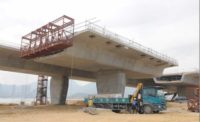China’s Ministry of Transport has revised upward sharply the cost estimate of a 55-kilometer-long bridge to connect Mainland China with Hong Kong city, by $1.5 billion. The new span’s cost is now pegged at $6.4 billion, the government says.
The project, which includes a bridge and a tunnel, will drastically cut travel time between Hong Kong, Macau and Zhuhai cities in China’s Pearl River Delta economic hub to one hour. At present, it takes four hours to travel by ferry between Hong Kong on the eastern side of the delta and Zhuhai on the western bank.
Hong Kong’s Dept. of Transport and Housing government reports that the project’s contractors have demanded more money due to complicated construction conditions, rising labor and material costs, and recent revisions to construction plans. Delays in construction, which have been caused due to political differences and anti-corruption investigations, have also contributed to the cost of the project, which was first approved in 2009.
The cost overruns will be shared by the governments of the three cities in the same proportion as their contribution to the project cost as decided earlier. The provincial government of Guangdong, which oversees Zhuhai, will cover 44.5% of the costs, the government of Hong Kong and Macau will provide 42.9% and 12.6% of the costs, respectively.
The Hong Kong government said in late November that the main structures of the bridge are expected to be completed by the end of this year. But the authorities are reluctant about announcing the date of completion of the bridge construction.
The government estimates bridge operating costs at $366 million per year. An estimated average of 20.72 million trips will be made by vehicles over the bridge each year, according to the Guangdong Development Reform Commission.
The Guangdong government recently announced it would charge 150 Chinese yuan (US$23) from each car as toll for use of 29.6 kilometers portion of the bridge, which falls in Mainland China. The charge for a shuttle bus would be 450 yuan (US$69). The announcement spurred social media protests with several people saying that the government should not charge for use of the bridge. Guangdong authorities have now agreed to hold a public hearing on the issue later this month.
The project involves a main bridge, two link bridges and a bypass. The proposed main bridge is a large sea crossing linking Hong Kong, Zhuhai and Macao.
The Main Bridge will be a dual three-lane carriageway with a bridge-and-tunnel structure form. It will run from the artificial island off Gongbei of Zhuhai to another artificial island just west of Hong Kong’s boundary, according to the Hong Kong government’s Highways department.
Another element of the project is the Hong Kong Link Road connecting the Main Bridge with the city’s boundary. It will comprise sea viaducts in the western waters of Hong Kong, tunnels running through the city’s Scenic Hill area and underneath its Airport Road and Airport Express Line, and at-grade roads on reclamation along the east coast of Airport Island.
The next link, called the Teun Mun Chek Lap Kok Link, will provide the most direct route between the city’s Northwest New Territories and the Main Bridge, the Airport and the North Lantau area and besides opening up an alternative route to the airport.
The northern connection of TM-CLKL will connect Tuen Mun area with the Hong Kong Boundary Crossing Facilities (HKBCF) via a sub-sea tunnel while the Southern Connection will connect the HKBCF and North Lantau on viaducts.
The project will also have a bypass called the Tuen Mun Western Bypass to connect Tuen Mun – Chek Lap Kok Link and Kong Sham Western Highway.
The network of bridges will be serviced by a huge passenger and cargo clearance facility which will be a strategic multi-modal transportation hub built on 130 hectares that would be reclaimed from open waters off the northeast of the Hong Kong International Airport. This artificial island will see construction of several buildings and transport facilities on this artificial island to provide passenger and cargo clearance services. Its overall design is “based on the principles of innovation, aesthetics, energy efficiency and sustainable development,” the Highways department said.


Post a comment to this article
Report Abusive Comment